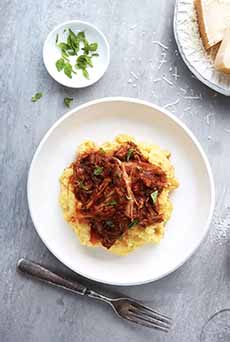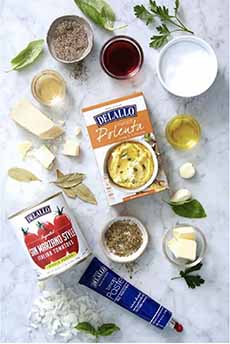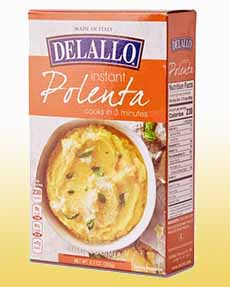Polenta & Pork Ragu Recipe For National Pork Month
|
|
In this recipe from DeLallo, the ragù is served Italian-style, atop polenta. But you can use it over pasta, rice, or other grains; and for a great brunch, serve it over scrambled eggs. A ragù (rah-GOO) is a meat-based sauce. The Italian word derives from the French ragoût, from the verb ragoûter, “to revive the taste.” Ragù can be made with any meat or game, but it’s especially good for the less expensive tough cuts that can be made soft and silky with a few hours of simmering. A ragù is usually made by adding meat to a soffritto*, a mixture of chopped onions, celery, carrots, and seasonings (garlic and fresh herbs such as parsley or sage), that is partially fried in olive oil. (Soffritto is the progenitor of the French concept of the mirepoix‡.) The vegetables are then simmered for a long time with tomato sauce. Two famous Italian ragùs for pasta: > Another recipe: Wild Boar Ragù With Pappardelle. > Turn leftovers into a ragoût stew. In this recipe, a tough pork shoulder is transformed into delicious, fall-apart goodness with a silky sauce. Prep time is 10 minutes, cook time is 3 hours 35 minutes. We added a sprinkle of fresh herbs because herbs fresh always add a lovely layer of flavor. 1. SEASON the pork with salt and pepper. Heat the oil in a large heavy pot over medium heat. Cook the pork, turning often until evenly browned, 10-12 minutes. Transfer to a platter and pour off the drippings. 2. ADD the onion and garlic to the pot and cook, stirring occasionally, until the onion is starting to brown and caramelize, 12-15 minutes. Add the tomato paste and cook, stirring occasionally, for 5-8 minutes. 3. ADD the wine and cook, scraping up any browned bits, until the liquid is reduced by half, 5-8 minutes. 4. ADD the tomatoes, crushing them with your hands as you go. Then add the basil, oregano, and bay leaves. Stir in 2 cups of water. Add the pork with any juices accumulated on the platter, and season with salt and pepper. 6. USING 2 forks, break up the pork into pieces. Taste and season with salt and pepper. Meanwhile… 7. COOK the polenta according to package instructions. Stir in the butter and cheese. 8. SPOON the polenta into bowls and top with the pork and sauce. Sprinkle with the herbs, or pass a ramekin of snipped herbs so people can add their own. |
|
|
________________ *Soffritto is sometimes called battuto in Italian, and usually refers to the uncooked mix of vegetables. It’s different from the Spanish sofrito, which may include garlic, bell peppers, tomato paste (or tomato sauce), and spices. †Mirepoix is a mix of aromatics, made from finely diced vegetables. The mix of vegetables can vary by country. The vegetables are cooked in butter or oil, cooked low and slow to sweeten the ingredients rather than caramelizing them with faster, high heat cooking. These slow-cooked aromatic vegetables form the first layer of flavor in many recipes. ‡For herbs, rosemary, sage, and thyme are classic pork pairings. But you can use basil or parsley if that’s what you have on hand. ‡‡Instant polenta is more finely ground and therefore cooks in as little as five minutes (as opposed to regular polenta which requires at least 40 minutes cooking time). Instant polenta is often less textural and, depending on the brand, can have less flavor when cooked. CHECK OUT WHAT’S HAPPENING ON OUR HOME PAGE, THENIBBLE.COM.
|
||


 Pork Shoulder[/caption]
Pork Shoulder[/caption]



